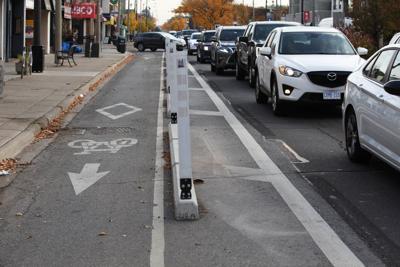According to my firefighter buddies, yes they do actually exist, what Chief Jessop was referencing was response times in the entire ward, not specifically along that particular stretch of Bloor west.
I'm curious, can someone post this recent article in The Star? It's only available to subscribers.
https://www.thestar.com/news/gta/to...cle_45978edc-a6a2-11ef-b3f2-4f266839ddf7.html
Toronto Fire worried Bloor bike lanes would slow response times, documents reveal
The decision to install temporary bike lanes during COVID — most became permanent — seemed to come as a surprise at the time to the then-fire chief.
Nov. 25, 2024
5 min read
Save
Data used to show the effect of Bloor West bike lanes on emergency response times has been flawed, critics say.
Michelle Mengsu Chang/Toronto Star

By
Francine KopunSenior Writer
Toronto Fire Services officials were concerned that bike lanes, including
lanes on Bloor Street West in Etobicoke, would slow emergency response times, and conducted internal research that supported those concerns, according to documents released to the Toronto Star.
The decision to install temporary bike lanes during COVID — most of which became permanent — seemed to come as a surprise at the time to then-fire chief Matthew Pegg, according to an email he sent to City of Toronto transportation chief Barbara Gray on May 25, 2020, after learning about the lanes on
CP24 that morning.
“Have we had the opportunity to analyze the impacts to emergency response travel times, both now and under “normal” traffic conditions,” he asked Gray, Toronto’s general manager of transportation services.
“Are these lanes intended to remain in place moving forward or will this be cancelled once traffic starts back up?”
Gray responded that the routes weren’t exactly news — they were in the city’s 10-year cycling plan and the three-year implementation strategy — but admitted the city had not conducted the same kind of consultations it would normally conduct when implementing bike lanes.
“The piece that did not happen is the typical door-to-door style consultation that we do with businesses and residents,” she wrote in response to Pegg’s email.
In the fierce debate about bike lanes on Bloor Street West in Etobicoke, between Runnymede and Resurrection roads, few angles have been more hotly contested than whether bike lanes have affected TFS emergency response times. The question of whether Toronto Fire was properly informed and consulted about bike lanes has also been raised.
Premier Doug Ford weighed in on the matter on Friday, when he told reporters at an event in Hamilton that concerns he’s heard from first responders are one reason his government has decided to
remove bike lanes on three major arteries in Toronto, including Bloor West in Etobicoke, Yonge Street and University Avenue.
“When the firefighters jump in their trucks and they’re trying to go down University and they’re jammed behind traffic if they can’t get there to save lives — or they’re trying to go down Bloor Street and it’s absolutely backed up from here to Timbuktu or Yonge Street — that doesn’t make sense at all,” said Ford.
“I’ve always believed that you don’t put (bike lanes) on main arterial roads, you put them on secondary roads so you don’t jam up the main roads.”
Toronto Deputy Fire Chief Jim Jessop had appeared to settle the issue of emergency response times at
a public meeting held in October, organized by local councillor Amber Morley (Ward 3, Etobicoke-Lakeshore), when he cited two statistics that show an improvement in response times in the ward.
Jessop said TFS was able to establish an effective firefighting force — which means getting the right number of trucks and firefighters to the scene at locations throughout the ward within a specified time frame — 89 per cent of the time before the bike lanes went in on Bloor Street West in Etobicoke, and 93 per cent of the time in 2024, after the bike lanes went in.
He also said there was almost no difference in how often the fire department was able to get first trucks to the scene in the required amount of time — TFS met the standard 70 per cent of the time in the ward in 2022, before the bike lanes, and 71 per cent of the time in the ward after the bike lanes.
Supporters of the bike lanes cheered the data, and have cited it as proof that bike lanes don’t cause delays for TFS emergency vehicles. Skeptics pointed out that improvements in response times across an entire ward reveal little about response times in a specific area.
Email exchanges between fire officials and city staff and internal research conducted by Toronto Fire Services and obtained by the Star under freedom-of-information laws seem to indicate that TFS was not kept in the loop at all times when it came to bike lanes, and that senior TFS staff had concerns the bike lanes would adversely affect emergency response times.
The FOI documents also reveal that TFS conducted internal research that found delays in areas where bike lanes had previously been installed, and predicted similar delays if they were extended along Bloor Street West in Etobicoke.
“There will likely be an effect on emergency response to and through this area compared to the existing conditions,” wrote Capt. Rob Mezzapelli, the TFS officer in the Emergency Planning Division tasked with looking into the issue, in an email to colleagues in August 2022.
The TFS data analytics department developed a methodology for doing an impact analysis of response times. The report compared the change in total response times along Bloor Street West between Shaw Street and Runnymede Road before and after bike lanes, in an effort to predict what might happen to emergency response times between Runnymede Road and Resurrection Road in Etobicoke if bike lanes were extended into that area.
The report found that total response times increased in the area between Shaw and Runnymede along Bloor West, before and after the bike lanes, but that the increase was roughly the same as an increase in response time across the city — about six per cent. Total response times count all the minutes, from the moment a call is received to the arrival of units at the scene. This is a variable that can be affected by changes that have nothing to do with actual travel times — for example, where a fire hall
keeps the printer and maps, can affect total response times.
The internal TFS report also concluded that the amount of time it takes trucks to travel from the station to the scene of the alarm — the amount of time spent on the road — did increase after the bike lanes were installed on Bloor between Shaw and Runnymede.
It found that between 2019 and 2022, travel times inside the bike lane area increased 52 seconds, from 257 seconds to 309 seconds. Events outside the area saw an increase in travel times of 40 seconds, from 322 seconds to 362 seconds.
“Travel time is increasing at a slightly higher rate in the 2020 extension area compared with events not occurring in the 2020 extension area,” the report concluded.
After reviewing the report, Mezzapelli expressed concerns that extending the bike lanes into Etobicoke would, in fact, increase emergency response times there.
“Looking at these projects from an emergency response perspective, I feel it is safe to say that implementing the changes mentioned above (installing bike lanes from Runnymede Road to Resurrection Road in Etobicoke) may have an impact on slowing response times and in certain situations may make truck turning manoeuvres more challenging,” Mezzapelli wrote in an email on Feb. 1, 2023, to colleagues.
In response to questions from the Star about the study, a TFS spokesperson said: “This analysis was based on a small geographical area which represented a relatively small sample size, compared to ward or city level, which has less variability.
“TFS is unable to isolate a specific cause for travel time increases due to a wide variety of variables (e.g., weather, construction, motor vehicle collisions, traffic, to name a few).
“Since the 2023 report, TFS has continually refined how this data is reported given smaller data sets have greater variability. Recently, in 2024, there was an
Interim Condition Data Update by Transportation Services for the Bloor Street West Complete Street Extension which included updated emergency response time data.” That data also shows an increase in emergency travel times — from October to December 2023, travel time for the first arriving truck at an incident increased 30 seconds compared over the same time period in 2022, while citywide it increased by two seconds.
Etobicoke Centre Coun. Stephen Holyday says the stats Jessop used at the meeting may have been reassuring to the public, but they don’t mirror what people see when they’re on the road — emergency response vehicles stuck in traffic.
“People couldn’t square it up,” said Holyday.
“That’s central to this discussion and why the public are so irate.”
With files from Robert Benzie







